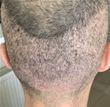What Is Donor Depletion?
Donor depletion refers to the donor site of a patient that has been severely compromised by over-harvesting a large number of follicular units for transplantation. Generally, donor depletion occurs with FUE more often then it does with strip surgery, this is because FUE requires a larger area for donor harvesting. Unfortuanately, the occurance of donor depeletion continues to grow each year, this is due to mega-sessions being performed on less than ideal candidates. Donor depletion leaves the donor site of patients looking moth-eaten and patchy.
What Is Shock Loss?
Telogen Effluvium commonly referred to as "shock loss" is a form of short-term hair loss that occurs from stress, trauma or a surgical procedure. Shock loss generally resolves on its own without treatment within three to six months. Hair follicles have three phases of life, the anagen (growth) phase, catagen (transitional) phase and the telogen (resting) phase. When trauma occurs a massive amount of hair follicles enter the telogen (resting) phase all at once, this creates a temporary appearance of thinning/balding. The hair loss may appear patchy over the donor site.
How Can You Tell The Difference Between The Two
Visibly speaking it is difficult to detect a difference between donor depletion and donor shock loss. However, there are some subtle clues that can help an individual determine if he is suffering from either condition. The first determining factor should be how many follicular unit grafts were removed during the surgical procedure. Anything over 3,000 grafts in one sitting is extremely risky and can lead to donor depletion. Another factor to consider is the timeframe between surgery and the thinning appearance. If the thinning appearance occured suddenly after surgery, it is likely to be shock loss. However, if the thinning appearance has lasted longer than six months with no visible changes each month, it is likely to be donor depletion.
Conclusion
Sadly, there isn't anything prospective patitents can do or take to avoid suffering from shock loss, but donor depletion can be easily avoided by going to an accredited, pre-screened hair transplant surgeon. Ultimately, the aesthetic and cosmetic outcome of the results depends on the skill, talent and experience of the hair restoration surgeon. For this reason, patients are encouraged to consult and research doctors slowly before committing to surgery.

